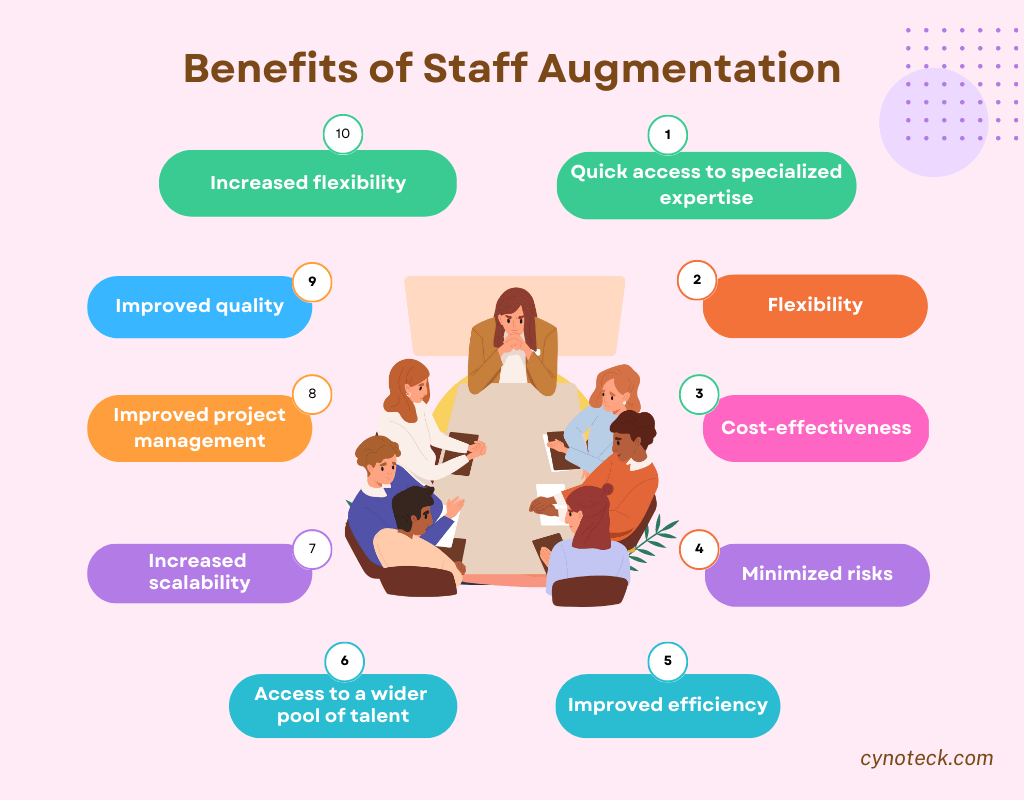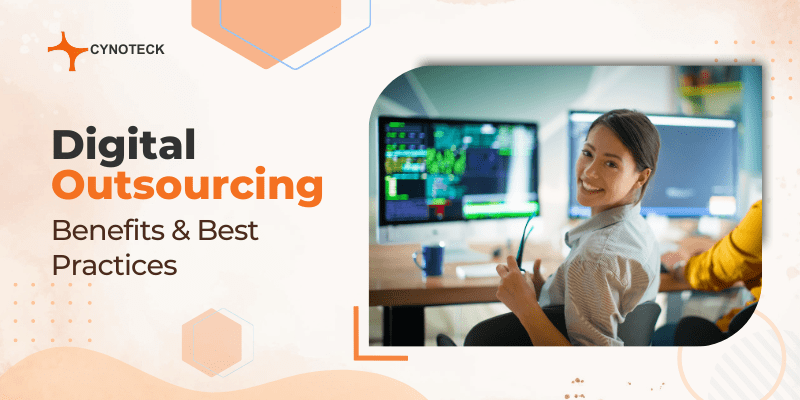According to Statista, the growth rate of developing technology would be 104% between 2018 and 2023. It is the era when competition is higher than ever. Turning your vision into reality should be quick and effective. Apps and web services are changing the world. If you want to build a service in dire need and require effective services, then it is wise to adopt IT staff augmentation.
This helps by assembling a temporary team, choosing team leaders and other delegates, and allocating the work in accordance with deliverables, it lets the company attain control over the project.
What is staff augmentation?
Staff augmentation is a business strategy in which a company brings in external workers or contractors to temporarily or permanently supplement its existing workforce. This can be done to address specific skills shortages or to provide additional support for specific projects or tasks.
There are various perks of using staff augmentation as a business strategy. It allows companies to quickly and easily bring in specialized expertise or additional resources when needed, without the need to hire permanent employees. It also gives companies the flexibility to scale their workforce up or down as needed, depending on the demands of their business.
The market for staff augmentation is worth $92.5 billion.
There are several different models for staff augmentation, including hiring contractors or temporary workers on a short-term basis, outsourcing specific tasks or projects to external companies, or partnering with a staffing agency to discover qualified candidates for specific roles.
In general, staff augmentation can be a useful strategy for companies looking to increase efficiency and flexibility, while minimizing costs and minimizing the risk of hiring permanent employees.
Looking for IT Staff Augmentation Services?
Send us your requirements, we will get back to you with a quote
How does staff augmentation work?
There are several different ways in which this can be done, including:
1. Hiring contractors or temporary workers on a short-term basis:
Companies can bring in contractors or temporary workers to work on specific projects or tasks for a defined period of time. These workers are typically not considered permanent employees and may not receive the same benefits as full-time staff.
2. Outsourcing specific tasks or projects to external companies:
Companies can also outsource specific tasks or projects to external companies or freelancers. This can be an effective way to bring in specialized expertise or additional resources when needed, without the need to hire permanent employees.
3. Partnering with a staffing agency:
Companies can also work with staffing agencies to find qualified candidates for specific roles. The staffing agency will handle the recruitment and onboarding process, and the workers will typically be considered temporary employees of the agency rather than the company.
In all of these cases, the goal of staff augmentation is to bring in additional resources or expertise when needed, while minimizing the costs and risks associated with hiring permanent employees. It allows companies to scale their workforce up or down as needed, depending on the demands of their business.
Also, read: Software Development Time Estimation: A Practice Guide
When to use Staff Augmentation Services?
There are several situations in which a company may consider using staff augmentation services:

1. Skills shortages:
If a company lacks the necessary skills or expertise in-house to complete a specific task or project, staff augmentation can be a good way to bring in specialized expertise on a temporary or permanent basis.
61% of larger companies are having trouble hiring data analysts, while 55% of larger companies are having trouble hiring software engineers.
2. Short-term projects or tasks:
Staff augmentation can be a good option for companies that need additional resources for a short-term project or task. This can help to avoid the need to hire permanent employees who may not have long-term work available.
3. Seasonal or cyclical work:
Staff augmentation can be a useful strategy for companies that experience regular fluctuations in workload, such as those with seasonal or cyclical work.
It allows them to bring in additional resources as needed, without the need to hire and train permanent employees.
4. Rapid growth:
Companies that are experiencing rapid growth may not have the time or resources to hire and train permanent employees quickly enough to meet the increased demand. Staff augmentation can be a good way to bring in additional resources on a temporary basis to help meet the increased demand.
India will continue to dominate the global market for offshore business services in 2023, closely followed by China, Malaysia, and Indonesia as per a report by Statista.
5. Cost-cutting:
Staff augmentation can be a cost-effective way for companies to bring in additional resources when needed, as they do not need to provide the same benefits and support as permanent employees.
This can be a good option for companies looking to cut costs or improve efficiency.
Also, read: The Ultimate Website Maintenance Checklist for Businesses
Staff augmentation Vs Outsourcing
Staff augmentation and outsourcing are two business strategies that involve bringing in external resources or expertise to support a company’s operations. However, there are some key notable differences between the two:
Staff augmentation involves bringing in external workers or contractors to temporarily or permanently supplement a company’s existing workforce. We can use can it on a short-term or long-term basis, depending on the needs of the company.
In staff augmentation, the company maintains control over the work being done, as the external workers or contractors are still considered part of the company’s workforce. It’s a cost-effective method for companies to bring in additional resources whenever required.
On the other hand, Outsourcing involves transferring the responsibility for a specific task or function to an external company or contractor. It typically involves a long-term commitment, as the external company or contractor takes on the ongoing responsibility for the task or function.
Outsourcing can also be cost-effective, as it allows companies to take advantage of lower labour costs in other countries or to access specialized expertise at a lower cost. However, outsourcing can also involve upfront costs associated with transitioning the work to an external provider.
Also, read: How Business Process Automation Can Help Your Business
Types of staff augmentation
There are several different types of staff augmentation, including:
1) Contract Staffing:
This involves hiring contractors or temporary workers on a short-term basis to work on specific projects or tasks. These workers are typically not considered permanent employees and may not receive the same benefits as full-time staff.
2) Project-based staffing:
This type of staff augmentation involves bringing in external workers or contractors to work on specific projects for a defined period of time.
3) Permanent staffing:
This involves hiring external workers or contractors on a permanent basis to fill specific roles within a company. These workers are typically considered permanent employees and receive the same benefits as other full-time staff.
4) Temporary staffing:
This involves hiring external workers or contractors on a temporary basis to fill specific roles within a company. These workers are typically considered temporary employees and may not receive the same benefits as permanent employees.
5) Outsource staffing:
This involves outsourcing specific tasks or projects to external companies or freelancers. This can be an effective way to bring in specialized expertise or additional resources when needed, without the need to hire permanent employees.
6) Offshore staffing:
This involves outsourcing specific tasks or projects to external companies or contractors in other countries, typically to take advantage of lower labor costs.
Also, read: Top 5 Field Service Automation Software to Accelerate Field Service
Types of staff augmentation services
There are several types of staff augmentation services that companies can use to supplement their existing workforce.
Such as IT staff augmentation which involves bringing in external IT professionals or contractors to work on specific projects or tasks, such as software development, system integration, or technical support. Then according to specific requirement workforce can be added. For example, companies can involve external engineering professionals for any specific tasks.
Likewise, marketing, finance, HR & legal, for any department’s external workforce can be added. Contractual employees can help in work on tasks such as content creation, budgeting, auditing, employee onboarding, and legal research or compliance.
For staff augmentation, Creative & Administrative, any task can be completed. Involving special projects such as graphic designs, data entry or customer services, etc.
Staff Augmentation benefits
There are several advantages to using staff augmentation as a business strategy. Let’s have a quick look at them:

- Quick access to specialized expertise: Staff augmentation allows companies to quickly and easily bring in specialized expertise or additional resources when needed, without the need to hire permanent employees.
- Flexibility: Staff augmentation gives companies the flexibility to scale their workforce up or down as needed, depending on the demands of their business.
- Cost-effectiveness: Staff augmentation can be a cost-effective way for companies to bring in additional resources when needed, as they do not need to provide the same benefits and support as permanent employees.
- Minimized risks: Staff augmentation can help to minimize the risk of hiring permanent employees, as it allows companies to bring in external workers or contractors on a temporary or project-by-project basis.
- Improved efficiency: By bringing in external workers or contractors with specialized expertise, companies can improve efficiency and productivity.
- Access to a wider pool of talent: Staff augmentation allows companies to access a wider pool of talent, both locally and globally, which can be especially useful for companies in areas with limited local talent.
- Increased scalability: Staff augmentation can help companies to scale their workforce up or down quickly and easily, depending on the needs of their business.
- Improved project management: By bringing in external workers or contractors with specific skills or expertise, companies can improve project management and ensure that projects are completed on time and within budget.
- Improved quality: Staff augmentation can help to improve the quality of work, as it allows companies to bring in highly qualified and experienced professionals when needed.
- Increased flexibility: Staff augmentation gives companies the flexibility to bring in additional resources as needed, without the need to hire permanent employees. This can be especially useful for companies that experience fluctuating workloads or that need to scale their workforce up or down quickly.
Also, read: Top 10 Help Desk Software for Small Business
Staff Augmentation challenges:
There are several challenges that companies may face when using staff augmentation as a business strategy:
- Integration with the existing workforce: Integrating external workers or contractors with the existing workforce can be challenging, as they may have different working styles and approaches.
- Managing expectations: Companies may need to manage the expectations of external workers or contractors, as they may not have the same level of commitment or loyalty to the company as permanent employees.
- Communication and collaboration: Effective communication and collaboration between the internal and external workforce can be a challenge, especially if the external workers or contractors are working remotely
- Managing costs: Companies may need to carefully manage the costs associated with staff augmentation, as it can be more expensive to bring in external workers or contractors on a short-term basis.
- Legal and compliance issues: Companies may need to navigate legal and compliance issues when working with external workers or contractors, such as employment laws and tax obligations.
If you want to avoid these challenges, you can check Cynoteck’s IT staff augmentation services. Cynoteck’s IT Staff Augmentation services offer a powerful way to help your business get the required skill, along with full-scale development support from our external team.
Looking for IT Staff Augmentation Services?
Send us your requirements, we will get back to you with a quote
Considerations and misunderstandings about staff augmentation
There’s a huge pool of possibilities for considerations and misunderstandings about staff augmentation. Following are a few points companies should be aware of when using staff augmentation as a business strategy:
- Legal and compliance issues: Companies may need to navigate legal and compliance issues when working with external workers or contractors, such as employment laws and tax obligations.
- Integration with the existing workforce: Integrating external workers or contractors with the existing workforce can be challenging, as they may have different working styles and approaches.
- Managing expectations: Companies may need to manage the expectations of external workers or contractors, as they may not have the same level of commitment or loyalty to the company as permanent employees.
- Communication and collaboration: Effective communication and collaboration between the internal and external workforce can be a challenge, especially if the external workers or contractors are working remotely.
- Misunderstanding of staff augmentation: Some companies may misunderstand the nature of staff augmentation, viewing it as a way to permanently replace their existing workforce rather than as a way to supplement it. This can lead to conflicts and negative perceptions among permanent employees.
- Cost management: Companies may need to carefully manage the costs associated with staff augmentation, as it can be more expensive to bring in external workers or contractors on a short-term basis.
- Misalignment with company culture: External workers or contractors may not always align with a company’s culture or values, which can lead to conflicts or difficulties in integration.
Also, read: What is Workflow Automation? And top Workflow Software for 2023
How Cynoteck can help you in staff augmentation?
Cynoteck with its top-notch IT Staff Augmentation Services provides essential skillsets for your company or IT goals, to bridge the gap between demand and supply and in your existing team for professional developers. Our staffing solutions help you keep up with business demands while also supporting and enhancing your technology initiatives.
Our recruiting model is innovative and top-notch, supported by a customer-focused software development team. Our IT staff augmentation services provide access to certified IT professionals, including experienced software developers, scrum masters, QA specialists, and business analysts. We can help you find the talent you need within your budget limitations.
You can contact us today to reach you with professional resources that offer a competitive edge for your business.
Conclusion
Staff augmentation is a practice that allows organizations to supplement their existing workforce with temporary or contract employees in order to access specialized expertise or handle a temporary increase in workload. It can be a cost-effective solution for organizations that need to scale their workforce up or down as needed and allows them to quickly and easily access the skills and expertise they need.
However, it is important to carefully consider the total cost of the engagement, including any fees charged by the staffing agency or consulting firm, and to clearly communicate your expectations and goals to the staff augmentation team.
IT staff augmentation can be a valuable tool for organizations that need to access specialized expertise on a temporary basis, but it is important to carefully consider the needs of the organization and the suitability of this approach before making a decision.
Also, read: What is Revenue Operations (RevOps)? – A Complete Guide
Frequently Asked Questions:
Staff augmentation is a business strategy in which a company brings in external workers or contractors to temporarily or permanently supplement its existing workforce.
Some benefits of IT staff augmentation include quick access to specialized expertise, flexibility, cost-effectiveness, minimized risk, improved efficiency, access to a wider pool of talent, increased scalability, improved project management, improved quality, and increased flexibility.
Some challenges of staff augmentation include integration with the existing workforce, managing expectations, communication and collaboration, managing costs, and legal and compliance issues.
Staff augmentation involves bringing in external workers or contractors to temporarily or permanently supplement a company’s existing workforce, while outsourcing involves transferring the responsibility for a specific task or function to an external company or contractor.
Staff augmentation can be appropriate in situations where a company lacks the necessary skills or expertise in-house to complete a specific task or project, needs additional resources for a short-term project or task, experiences regular fluctuations in workload, is experiencing rapid growth, or is looking to cut costs or improve efficiency.

CRM Consulting services
Do you want to implement a CRM system within your organization? Connect with our CRM Experts today!





Thank you for sharing very useful information.